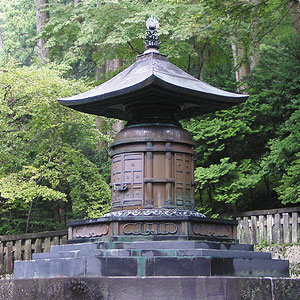|
||
 |
||
Houtou are associated especially with the early Heian period, when the Esoteric Buddhist sects, Tendai Vä and Shingon ^¾, were introduced to Japan. They have been associated with the legend that *Shaka ßÞ, the founder of Buddhism, was one day expounding the Lotus Sutra HOKEKYOU @Øo when the Buddhist deity, Tahou nyorai, moved by this show of devotion and respect, caused a pagoda to appear in which he sat and permitted Shaka to sit beside him. An ink drawing from the Kamakura period shows the two deities sitting inside a houtou with its doors open. The body of the houtou rests on a lotus flower. The rendering of the roof indicates that it is tiled *kawarayane ¢®ª. There is a finial crowned with a ball-shaped sacred jewel *houju óì, from which emanate various stems which end in bud-like shapes. Most houtou are made of stone but some gilt bronze and iron houtou exist. Wood and dried mud houtou are very rare but one such houtou is owned by the Kawase family in Nara. It is dated Muromachi period and is completely cylindrical. Large wooden buildings constructed as houtou are also rare. One constructed in 1830 at Honmonji {å, Tokyo is 17.4m tall. It has wooden walls covered with plaster, and eight pillars that surround the shaft to make the structure 5.7m wide. Twelve more pillars form a circle above the cornice. The roof is covered with copper sheeting and has a finial above it.
A dried mud houtou, dated between 897-1185, was unearthed in Okayama prefecture and is owned by Shoufukuji. Miniature versions are found as attributes *jimotsu ¨ held by the deities *Miroku íèÓ and *Bishamonten ù¹åV. Examples include the Bishamonten is in Touji , Kyoto, and in Houryuuji @², Nara.

Nikkou Toushouguu Okusha úõÆ{Ð (Tochigi)
2@A pagoda used in gardens. As with *gorintou ÜÖ, usually only their separate parts are used, especially the shaft or central part or the roof-like coping. The shaft is called kesagata U¾`, meaning priests robe shape. Large houtou are set in place with the neck part up; small ones with neck part down.
3@An abbreviation of *tahoutou ½ó.
@
(C)2001 Japanese Architecture and Art Net Users System.@No reproduction or republication without written permission.
fÚÌeLXgEÊ^ECXgÈÇASÄÌRec̳f¡»E]ÚðֶܷB

